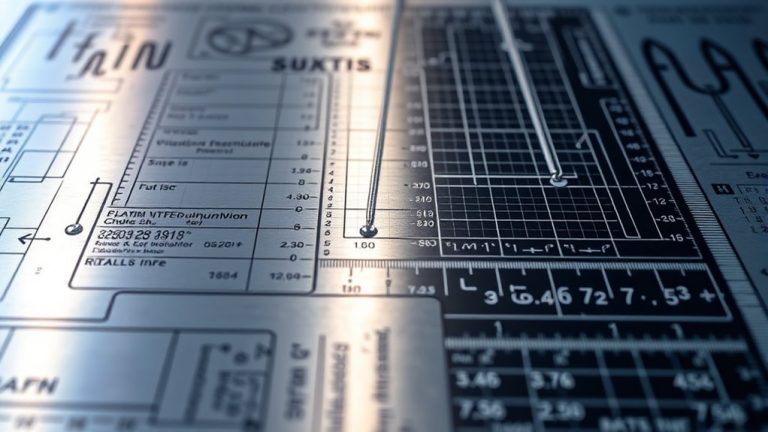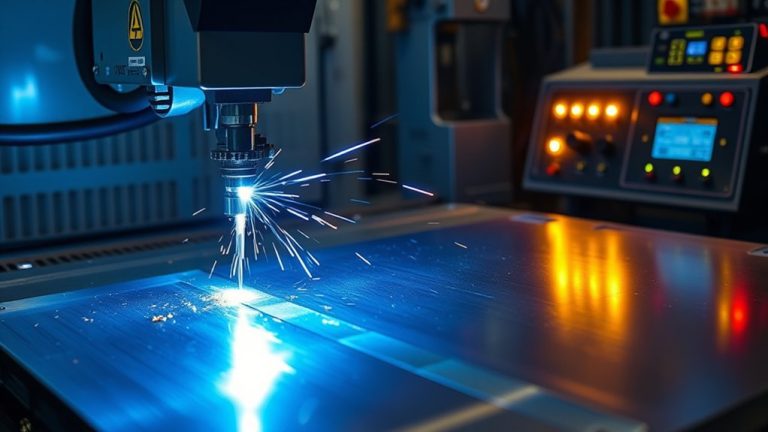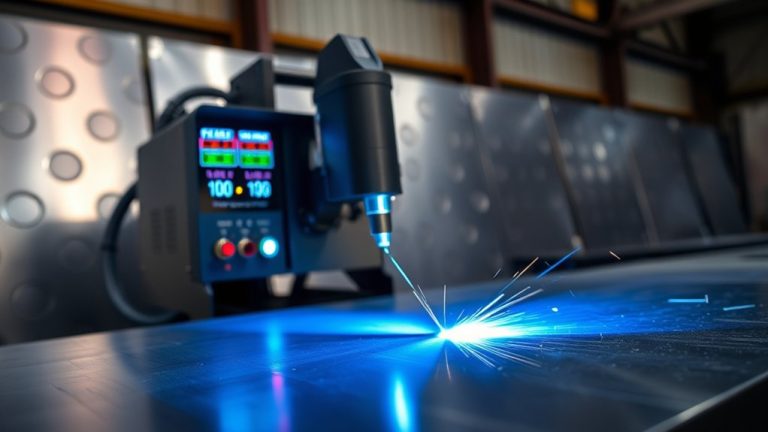Have you explored the theory that a plasma cutter specifically designed for aluminum can greatly improve cut quality? This claim hinges on aluminum’s unique properties, such as its low melting point and softness. By selecting the right plasma cutter, you guarantee precision and minimize defects like dross. Gas choice, maintenance, and settings play an essential role in achieving ideal results. Uncover the vital factors that make aluminum plasma cutting efficient and effective.
Understanding Plasma Cutting and Aluminum Properties

When you’re diving into the specifics of plasma cutting aluminum, understanding its properties is vital for precision and quality. Aluminum’s low melting point and soft nature make it ideal for plasma cutting, but achieving optimal cut quality demands precise gas selection and equipment settings.
For aluminum under 5 mm, using nitrogen as both the plasma and shield gas guarantees superior edge quality and dross-free surfaces. For thicker materials, combining nitrogen plasma gas with a water shield gas enhances results.
It’s important to maintain a consistent standoff distance from the workpiece and adhere to manufacturer guidelines. This approach prevents oxidation, which can degrade edge quality.
The Hypertherm XPR systems, with their VWI technology, are engineered to handle aluminum up to 50 mm thick, with piercing capabilities extending to 38 mm. Their advanced capabilities guarantee precision cutting, allowing you to achieve smooth, clean cuts without compromising material integrity.
Equipment and Techniques for Optimal Aluminum Cutting

To achieve ideal aluminum cutting, the right equipment and techniques are essential. Start by selecting a plasma cutter with a 100% duty cycle to guarantee prolonged cutting without overheating.
For superior cut quality, adopt precise cutting techniques: maintain a consistent torch movement and distance from the workpiece to reduce dross. Consult the owner’s manual for proper amperage settings based on aluminum thickness, guaranteeing peak performance.
For aluminum cutting under 5 mm thick, use nitrogen gas as both plasma and shield gases. For thick aluminum over 6 mm, combine nitrogen plasma gas with a water shield gas to enhance cut quality.
Proper setup is vital; clean the cutting area and verify your compressed air supply is dry to avoid contamination. Regular maintenance of your equipment will prolong its lifespan and maximize performance, ensuring each cut meets industry standards.
With these techniques, achieve precision in every cut.
Gas Selection and Its Impact on Cut Quality

Mastering the art of aluminum cutting not only involves equipment selection and technique but also hinges on the right choice of gases. Gas selection directly influences cut quality, determining whether you achieve smooth, dross-free cuts or contend with rough edges and excess dross. For aluminum cutting under 5 mm, nitrogen serves as the best plasma and shield gas, fostering smooth cuts. When tackling thicker material over 6 mm, pairing nitrogen with water as the shield gas minimizes edge contamination and enhances cut quality. Dual gas systems employing non-oxidizing gases are vital in producing weld-ready cuts, eliminating the need for extensive post-processing. Missteps in gas selection can lead to increased dross and rough surfaces.
| Material Thickness | Plasma Gas | Shield Gas |
|---|---|---|
| < 5 mm | Nitrogen | Nitrogen |
| > 6 mm | Nitrogen | Water |
| Dual System | Non-oxidizing | Varies |
Adhere to manufacturer guidelines for best gas settings and superior results.
Safety Considerations in Aluminum Plasma Cutting

In aluminum plasma cutting, safety isn’t just a recommendation; it’s a necessity that requires meticulous attention to detail.
When cutting aluminum, plasma cutters can generate hydrogen gas, especially near a water table, posing significant explosion hazards. Ensuring a safe distance between the water and aluminum is essential. Proper ventilation systems and fume extraction are critical to manage hazardous fumes and aluminum dust. These systems not only enhance safety but also maintain ideal cut quality.
Using a water table can reduce fumes and improve cut quality; however, it demands vigilance to prevent hydrogen gas buildup.
Always equip yourself with safety equipment—gloves, goggles, and protective clothing are non-negotiable to shield against high temperatures and molten metal. Understanding and respecting equipment limitations, alongside proper maintenance, are important to preventing accidents and ensuring efficient operation.
Prioritizing these safety measures will facilitate a safer and more effective aluminum cutting process.
Choosing the Right Tools for Aluminum Cutting Tasks

When commencing aluminum cutting tasks, selecting the right tools is paramount to achieving precision and efficiency. For ideal plasma cutting, consider devices like the Hypertherm Powermax or Razorweld 45, which guarantee high-quality cuts on aluminum. To attain the best cut quality, choosing the correct cutting gas is essential. Utilize nitrogen plasma for materials under 5 mm and a nitrogen and water shield combination for thicker aluminum.
Aluminum Cutting Tools
| Tool/Setting | Purpose |
|---|---|
| Hypertherm Powermax | Achieving high-quality cuts |
| Razorweld 45 | Guaranteeing precision and reliability |
| Nitrogen plasma | Ideal for thin aluminum cuts |
| Plasma cutter settings | Aligns with guidelines for accurate cuts |
| Guide for straight cuts | Enhances edge quality |
Adjust plasma cutter settings—amperage and torch speed—to manufacturer guidelines for clean cuts with minimal dross. Maintain a 100% duty cycle for continuous aluminum cutting, guaranteeing consistent performance. Employ a guide for straight cuts to improve edge quality, resulting in precise, accurate cuts.
Frequently Asked Questions
Does a Plasma Cutter Work on Aluminum?
Like a hot knife through butter, a plasma cutter works wonders on aluminum. Embrace its advantages by mastering cutting techniques, following safety precautions, maintaining equipment, and optimizing settings. Avoid common mistakes and consider its cost-effectiveness for projects.
How Thick Can a Plasma Cutter Cut Aluminum?
You can cut aluminum up to 75mm thick with a plasma cutter, considering plasma cutter thickness and aluminum cutting capabilities. Factors like power requirements, cutting speed, and aluminum alloy types affect material thickness limits. Follow safety precautions.
Can You Plasma Cut Aluminum With Compressed Air?
Sure, you can plasma cut aluminum with compressed air, but don’t expect miracle results. Focus on cutting techniques, using the right nozzle types, and ensuring air quality for arc stability. Remember, consumable lifespan and safety precautions are key!
What Is the Best Tool for Cutting Aluminum?
For cutting aluminum, plasma cutters excel. Consider advanced models like Hypertherm XPR for superior cut quality. Evaluate aluminum thickness, cutting speed, and tool portability. Follow maintenance and safety guidelines. Explore budget options with advanced features for ideal results.
Conclusion
When it comes to plasma cutting aluminum, think of your setup as a finely-tuned orchestra. Each component—from the nitrogen gas to the 100% duty cycle plasma cutter—plays its part in achieving a symphony of precision. By maintaining the right standoff distance and amperage settings, you guarantee clean, dross-free edges. Regular equipment maintenance is your conductor, keeping everything in harmony. With these techniques, your cuts will always hit the high notes of quality and efficiency.



